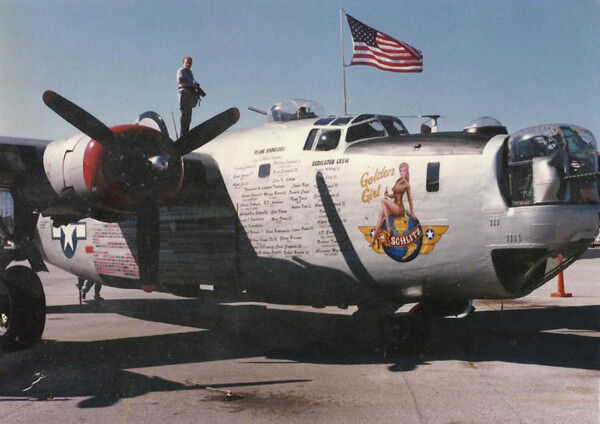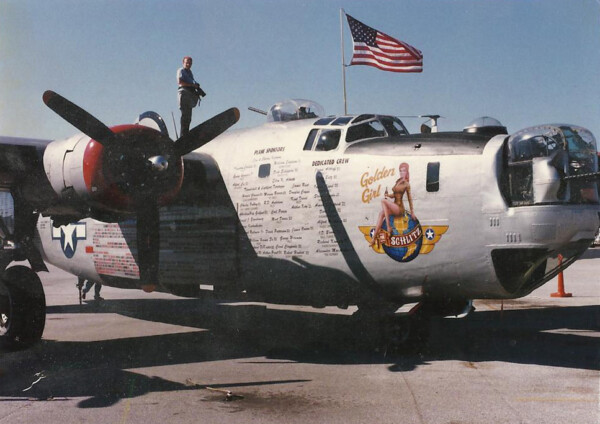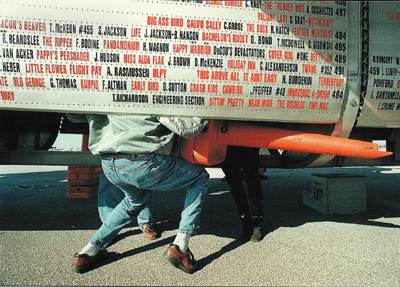Jeff Newell will not be the last of his kind, but he will be the best

While the nose art indicates the name of this Collings Foundation B-24 is "Golden Girl," the plane was known as the "All American." Journalist Bruce Brewer stands atop the fuselage prior to the flight from Panama City to Crestview in March 1998. Image courtesy of Del Stone Jr.
The afternoon was cold, and Jeff Newell was trembling.
“We get to go flying!” he enthused, rubbing his hands together, his voice rising and falling in a little boy’s sing-song. The freezing wind mattered little. More important was the aging World War II bomber “All American,” a B-24 Liberator of the type that had brought ruin to Hitler’s Third Reich.
The last of its kind, “All American” is maintained by the Collings Foundation a warbirds preservation group in Massachusetts. Mr. Newell was one of three Daily News journalists invited to fly the short hop between Panama City and Crestview.
Later he would write about this flight, and through his story the American wartime experience – and many other things that cannot be put to words – would be passed along to a new generation of Daily News readers.
Which was Mr. Newell’s talent as a journalist: bringing to life the arcane, from matters of history to the complexities of city government to court cases dense as hundred-year-old fruitcake.
In our Fourth Estate world of deadlines and fact-checking, Mr. Newell was a reporter’s reporter – relentless digger who knew what questions to ask and where the answers were hidden. He performed this duty at newspapers across Northwest Florida, from Pensacola to Panama City.
He was honest and fair and dedicated to the relating of facts, a simple ethic that endeared him to readers and sources alike. If you read it in a Jeff Newell story, you knew it was true.
His job never darkened his enthusiasm for life, be it flying on an airplane, playing trumpet in the community band or hamming it up with shortwave radio operators around the world.
This same enthusiasm carried Mr. Newell through the emotional and physical roller coaster of cancer. During the years he waged war with that disease, he displayed a dignity, patience and strength that inspired everyone around him.
Jeff Newell died on July 15, 2001.
Of the World War II veterans who came to see the B-24 “All American” on that 1998 visit to Panama City and Crestview, he wrote”
“They show up for just one more glimpse, searching in the polished aluminum for a reflection of the best days of their lives.”
Mr. Newell was very much like that old airplane: a rugged, reliable classic who got the job done.
Search the pages of this newspaper and we hope you will see a reflection of his character – his hard work, his honesty, his dedication to the craft of journalism. He will not be the last of his kind, but he will always be the best.
In the days when stories were filed by telegraph, it was the practice of reporters to end each transmission with a “30,” indicating the story had come to an end.
It is with fondess, and sadness, that we call an end to Jeff Newell’s time with us. He will be missed.
– 30 –
This editorial was published in the Northwest Florida Daily News in July 2001 and is used with permission.

Image courtesy of Del Stone Jr.
When you’re next at a bookstore or newsstand, be sure to pick up the premiere issue of Vent magazine.
Vent is published by Marta Randall, who is the wife of somebody you probably know: Rush Limbaugh.
What you don’t know is that a couple of Daily News journalists contributed to Marta’s magazine.
Managing Editor Debbie Lord and Staff Writer Wendy Victora both published multiple short articles in Vent’s fledgling issue.
Before you trouble yourself to look, be aware the stories have no bylines. And I’m ashamed to say I don’t remember which ones Debbie and Wendy wrote – if I ask, they’ll become suspicious, glom on to the fact I’m writing about their impressive accomplishment in my column, and threaten me with physical harm. (They’re needlessly modest, but they do pack a wallop.)
Sp pick up your copy of Vent. Try to guess who wrote what. And bring your copy by for an autograph – they’ll blush to their roots.
—
Recently I wrote about my good fortune to ride from Panama City to Crestview aboard the B-24 All American, restored and operated by the Collings Foundation. The trip provided me with an unexpected windfall.
As I was describing the flight to my bowling pals, one fellow, Chuck Patterson, asked if I had any photos of that airplane.
Did I have photos? Does Disney World have rides?
I brought Chuck a picture of the Liberator, and the next week he returned it – with an absolutely beautiful pencil-drawn version. He also showed me his portfolio – it is crammed with fantastic, photo-realistic renderings of aircraft from different wars and different eras.
Chuck is also a modest fellow. He keeps these drawings to himself. I think they’re worthy of a showing, or of sale, but he produces them pretty much for his family and friends.
But if you’re a fan of aviation art, you need to check out the work of this talented artist.
—
I was more amazed than amused by the piece in Sunday’s Commentary section that took news outlets to task for overhyping all the spree shootings at schools.
The column, by Vincent Shiraldi, director of a research institute in Washington, D.C. (now THERE is a hotbed of clear-thinking), lambasted news organizations for creating a false impression that these shootings constituted a trend. He said that media reports were overblown, and that stories about the shootings indirectly contributed to bad laws and more shootings. Juvenile murder rates are down, Shiraldi pointed out.
Gosh.
While it may be true that juvenile murder rates are down, it is also true that when an individual – be it a child, teenager or adult – shoots and kills four people and wounds dozens of others, no matter where it happens, IT’S NEWS. It’s worthy of coverage. And it deserves exactly the kind of coverage the Oregon shootings received.
Also, when something this heinous and bizarre happens – four, five, six times in a short period of time – it can safely be called a “trend.”
To blame bad laws and copycat crimes on the messenger is to say, in effect, that people are too stupid to sort things out for themselves. Better let the think tanks handle the thinking.
I don’t think so.
This column was originally published in the June 3, 1998 edition of the Northwest Florida Daily News and is used with permission.
About the author:
Del Stone Jr. is a professional fiction writer. He is known primarily for his work in the contemporary dark fiction field, but has also published science fiction and contemporary fantasy. Stone’s stories, poetry and scripts have appeared in publications such as Amazing Stories, Eldritch Tales, and Bantam-Spectra’s Full Spectrum. His short fiction has been published in The Year’s Best Horror Stories XXII; Alfred Hitchcock’s Mystery Magazine; the Pocket Books anthology More Phobias; the Barnes & Noble anthologies 100 Wicked Little Witch Stories, Horrors! 365 Scary Stories, and 100 Astounding Little Alien Stories; the HWA anthology Psychos; and other short fiction venues, like Blood Muse, Live Without a Net, Zombiesque and Sex Macabre. Stone’s comic book debut was in the Clive Barker series of books, Hellraiser, published by Marvel/Epic and reprinted in The Best of Hellraiser anthology. He has also published stories in Penthouse Comix, and worked with artist Dave Dorman on many projects, including the illustrated novella “Roadkill,” a short story for the Andrew Vachss anthology Underground from Dark Horse, an ashcan titled “December” for Hero Illustrated, and several of Dorman’s Wasted Lands novellas and comics, such as Rail from Image and “The Uninvited.” Stone’s novel, Dead Heat, won the 1996 International Horror Guild’s award for best first novel and was a runner-up for the Bram Stoker Award. Stone has also been a finalist for the IHG award for short fiction, the British Fantasy Award for best novella, and a semifinalist for the Nebula and Writers of the Future awards. His stories have appeared in anthologies that have won the Bram Stoker Award and the World Fantasy Award. Two of his works were optioned for film, the novella “Black Tide” and short story “Crisis Line.”
Stone recently retired after a 41-year career in journalism. He won numerous awards for his work, and in 1986 was named Florida’s best columnist in his circulation division by the Florida Society of Newspaper Editors. In 2001 he received an honorable mention from the National Lesbian and Gay Journalists Association for his essay “When Freedom of Speech Ends” and in 2003 he was voted Best of the Best in the category of columnists by Emerald Coast Magazine. He participated in book signings and awareness campaigns, and was a guest on local television and radio programs.
As an addendum, Stone is single, kills tomatoes and morning glories with ruthless efficiency, once tied the stem of a cocktail cherry in a knot with his tongue, and carries a permanent scar on his chest after having been shot with a paintball gun. He’s in his 60s as of this writing but doesn’t look a day over 94.
Contact Del at [email protected]. He is also on Facebook, twitter, Pinterest, tumblr, TikTok, and Instagram. Visit his website at delstonejr.com .

Despite the name "Golden Girl" appearing near the nose of this B-24, it's real name is "All American" and was operated by the Collings Foundation of Massachusetts. The author flew aboard the "All American" on a hop from Panama City to Crestview in March 1998. Image courtesy of Del Stone Jr.
On March 4 it was my honor to fly aboard the “All American,” the world’s only operational B-24 Liberator. This World War II-era bomber, restored and operated by the Collings Foundation of Stowe, Mass., flew from Panama City Airport to Bob Sikes Airport in Crestview along with the “Nine-O-Nine,” a similarly restored B-17.
This is what our flight was like:
As you stand in the prop wash of those big Pratt & Whitney engines, memories that aren’t even yours blow over you: strains of Benny Goodman and images of skinny 19-year-olds in flak vests and a fervent wish that no matter what happens, the old girl is good for one more ride.
You crawl through a hatch on the bottom of the fuselage. Your first impression is that this is not your father’s Oldsmobile – it’s your grandfather’s.

Virtually everything that is covered up, carpeted or padded in a commercial airliner is laid out for all the world to see – steel ribs, control cables, ammo boxes, oxygen tanks, rotating gun turrets – everything.
They fire up the engines and clouds of white exhaust sweep into the wash, something called “churn and burn,” according to a former tail gunner who’d come out to see her take off. It’s oil that seeped into the cylinders. It burns off.
Once all four engines are running cleanly you taxi out to the runway. The engine noise is deafening – you have to shout at the guy sitting next to you to make yourself heard.
When they throttle up to take off, she sprints down the runway with amazing power. The landscape rushes by with increasing velocity, the sound of the wind grows louder, and the old girl bounds into the air.
This is flying like you’ve never experienced. The waist gun ports, about the size of your refrigerator door, are totally open. Stick your head out there and see what 300 mph feels like.
You have to be careful where you step. The bomb bay doors, for instance, are designed to tear away if something heavy – like you – falls on them. Slip off the narrow catwalk and there’s nothing between you and the ground but 2,000 feet of Northwest Florida afternoon.
Wind howls through the aft part of the airplane. The cold is amazing. You think of those kids in their fleece-lined jackets, aiming .50-calibers at incoming fighters, and you wonder how in the name of God they did it.
The trip takes an hour. When you get to Crestview, you come in at treetop level and buzz the airport. The world spins crazily as you climb and simultaneously bank for the go-around to land.
You get out and pat her on the fuselage and tell her, “Good airplane,” and two important changes have taken place over the afternoon.
Now that you’ve had a taste of what it was like to fly in these airplanes, you have a new awe and respect for the men who flew them into war.
And maybe you’re a little said that never, not in your entire life, will you ever do anything as fine as what those men did.
But you have done something that not many people will get to do anymore. You flew aboard a B-24 Liberator.
The old girl was good for one more ride.
This column was originally published in the Wednesday, March 11, 1998 edition of the Northwest Florida Daily News and is used with permission.
About the author:
Del Stone Jr. is a professional fiction writer. He is known primarily for his work in the contemporary dark fiction field, but has also published science fiction and contemporary fantasy. Stone’s stories, poetry and scripts have appeared in publications such as Amazing Stories, Eldritch Tales, and Bantam-Spectra’s Full Spectrum. His short fiction has been published in The Year’s Best Horror Stories XXII; Alfred Hitchcock’s Mystery Magazine; the Pocket Books anthology More Phobias; the Barnes & Noble anthologies 100 Wicked Little Witch Stories, Horrors! 365 Scary Stories, and 100 Astounding Little Alien Stories; the HWA anthology Psychos; and other short fiction venues, like Blood Muse, Live Without a Net, Zombiesque and Sex Macabre. Stone’s comic book debut was in the Clive Barker series of books, Hellraiser, published by Marvel/Epic and reprinted in The Best of Hellraiser anthology. He has also published stories in Penthouse Comix, and worked with artist Dave Dorman on many projects, including the illustrated novella “Roadkill,” a short story for the Andrew Vachss anthology Underground from Dark Horse, an ashcan titled “December” for Hero Illustrated, and several of Dorman’s Wasted Lands novellas and comics, such as Rail from Image and “The Uninvited.” Stone’s novel, Dead Heat, won the 1996 International Horror Guild’s award for best first novel and was a runner-up for the Bram Stoker Award. Stone has also been a finalist for the IHG award for short fiction, the British Fantasy Award for best novella, and a semifinalist for the Nebula and Writers of the Future awards. His stories have appeared in anthologies that have won the Bram Stoker Award and the World Fantasy Award. Two of his works were optioned for film, the novella “Black Tide” and short story “Crisis Line.”
Stone recently retired after a 41-year career in journalism. He won numerous awards for his work, and in 1986 was named Florida’s best columnist in his circulation division by the Florida Society of Newspaper Editors. In 2001 he received an honorable mention from the National Lesbian and Gay Journalists Association for his essay “When Freedom of Speech Ends” and in 2003 he was voted Best of the Best in the category of columnists by Emerald Coast Magazine. He participated in book signings and awareness campaigns, and was a guest on local television and radio programs.
As an addendum, Stone is single, kills tomatoes and morning glories with ruthless efficiency, once tied the stem of a cocktail cherry in a knot with his tongue, and carries a permanent scar on his chest after having been shot with a paintball gun. He’s in his 60s as of this writing but doesn’t look a day over 94.
Contact Del at [email protected]. He is also on Facebook, twitter, Pinterest, tumblr, TikTok, and Instagram. Visit his website at delstonejr.com .